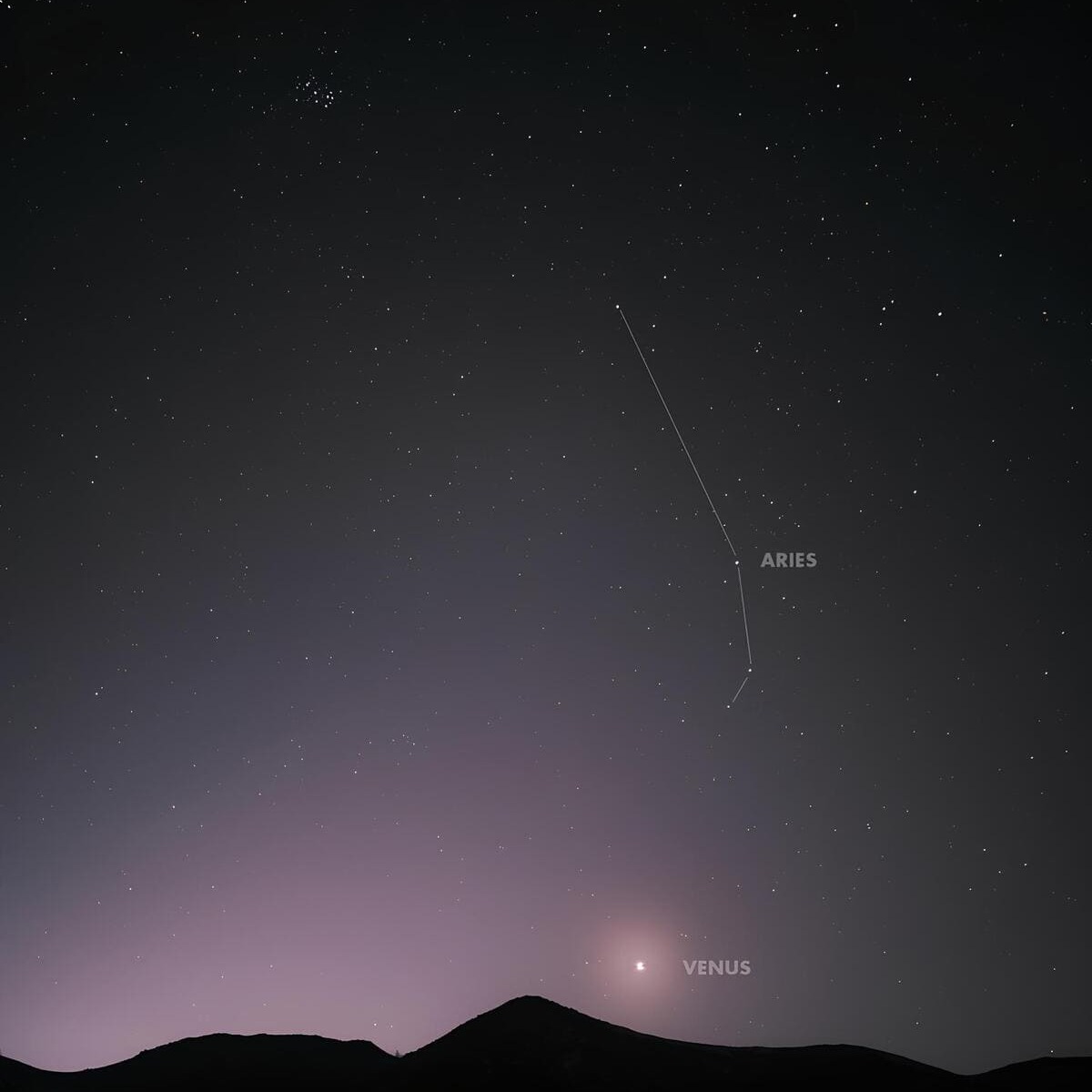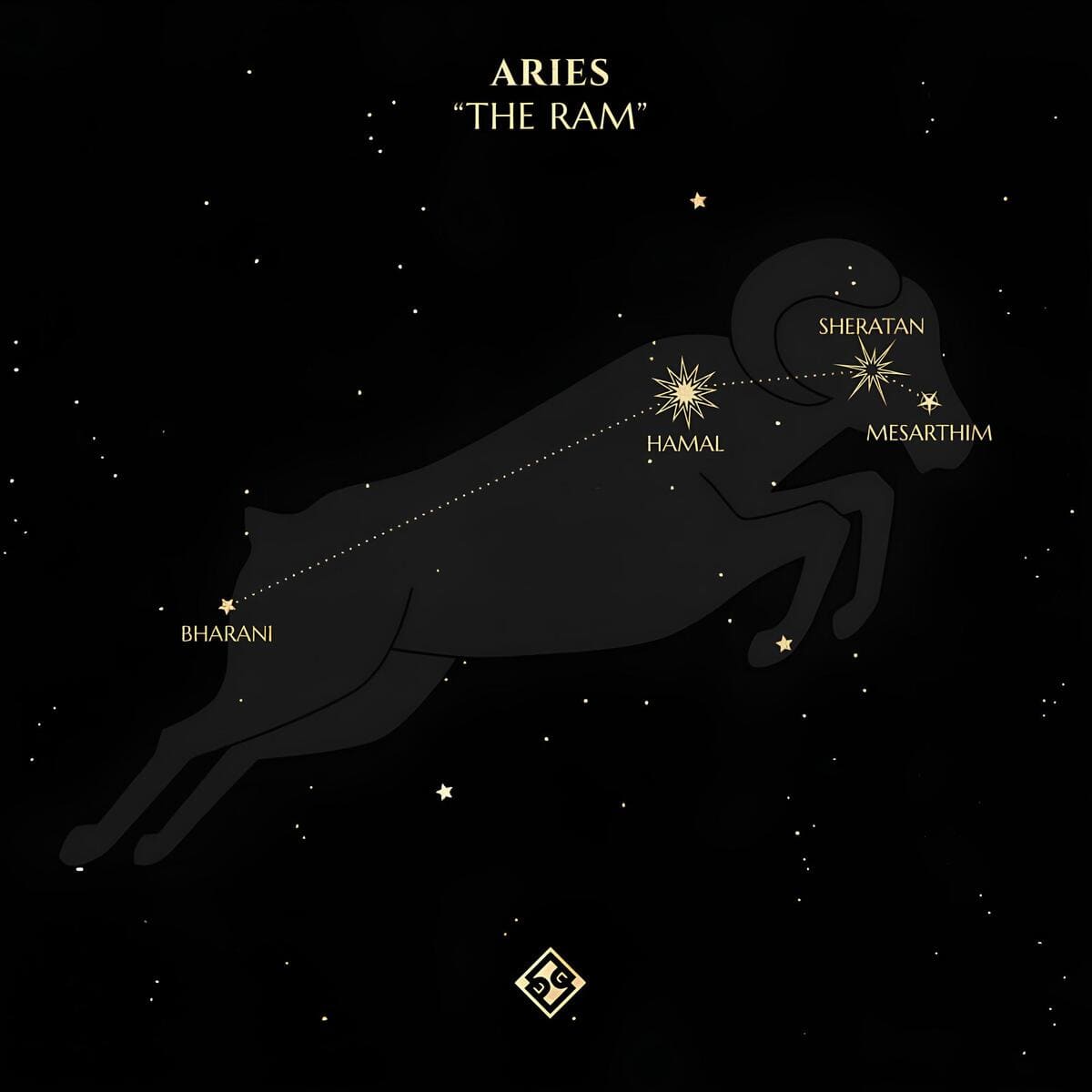You’ve got your eyes on the sky, eager to explore the constellations. Aries, the Ram, is on your list, but it seems elusive—smaller and less noticeable than other night sky formations.
While the prospect of spotting Aries excites you, the constellation’s modest size and less-than-brilliant stars can make your hunt frustrating. Add to that the confusion of celestial coordinates, and your enthusiasm could quickly wane.
Fear not, stargazer. This article is your comprehensive guide to finding and enjoying Aries in the night sky. From its best viewing times to a star-hopping guide, you’ll gain all the knowledge and tips to make Aries a highlight of your celestial journey.
Key Things to Know:
- The Aries constellation is best observed during late autumn and early winter.
- To locate Aries, look between Taurus and Pisces in the night sky, aiming for celestial coordinates of 3 hours in right ascension and a declination of +20 degrees.
- The constellation comprises four main stars: Hamal, Sheratan, Mesarthim, and Botein. Hamal is the brightest, with a magnitude of 2.00.
- Aries has a rich mythological background, representing a Ram with a Golden Fleece in Greek mythology.
Introduction: Aries Constellation

Hey there, stargazers! Are you ready to venture into the celestial landscape? Today, we’re focusing on Aries, the Ram, a constellation I’ve spent countless nights observing.
“Aries” is derived from the Latin word for “Ram.” Though less significant than other constellations, Aries has its unique attributes that make it worth your time.
Aries is one of the 12 zodiacal constellations. These constellations lie along the ecliptic plane and are significant in astronomy and astrology. Being a zodiacal constellation means that the Sun, Moon, and planets like Jupiter and Venus frequently pass through Aries, making them more prominent in astrological discussions.
Aries is steeped in mythological lore that adds a sprinkle of storytelling magic to your observation. In Greek mythology, Nephele was the cloud nymph who created the Ram. At the same time, Ino played a role in the Ram’s journey, contributing to the lore behind the Aries constellation.
Aries is one of the 88 official constellations, as defined by the International Astronomical Union (IAU).
Difficulty Level
Aries poses a moderate challenge for new stargazers. From my experience, its stars aren’t the brightest, but once you learn the tricks, it gets easier to spot. Some stars in Aries are variable, meaning their brightness changes over time.
Best Time to Observe Aries
If Aries is on your must-see list, mark late autumn and early winter on your calendar.
During these months, Aries ascends in the eastern sky as the Sun sets. The sun transits through the Aries constellation from late March to late April in the Tropical Zodiac. Therefore, April is a significant month for Aries in astrology and some forms of astronomy.
Observing Aries during a New Moon can enhance the visibility of its dimmer stars. The view of Aries can be truly spectacular when observed under the right conditions.
In my years of stargazing, I find late autumn evenings perfect for capturing Aries at its best. During the Spring Equinox, Aries is one of the first constellations in the evening sky.
FREE STARGAZING CHECKLIST
My 5-page Stargazing Checklist will enhance your astronomical observations.
Follow this free checklist to navigate the night sky with confidence, clarity, and a sense of preparedness for a rewarding stargazing experience.

Location of Aries in the Night Sky
To spot the constellation Aries, you’ll want to look between Taurus and Pisces. If you’re familiar with celestial coordinates, aim for a right ascension of 3 hours and a declination of +20 degrees. I’ve found these coordinates to be a reliable guide for catching a glimpse of Aries using a star map. Aries is also located not too far from the Gemini constellation. Aries is also neighbored by the constellation Pegasus to the east.
Jargon Alert:
Right Ascension is an astronomical coordinate used to locate stars and other celestial objects on the celestial sphere. It’s akin to longitude on Earth. Measured in hours, minutes, and seconds, it starts from the vernal equinox and moves eastward along the celestial equator.
Declination is another astronomical coordinate, working alongside right ascension. Think of it as the celestial version of latitude. It measures the angular distance of an object north or south of the celestial equator, ranging from +90 degrees at the North Celestial Pole to -90 degrees at the South Celestial Pole.
Star-hopping Guide to Find Aries
- Start off by locating the Pleiades cluster in Taurus. It’s a bright, beautiful collection of stars that’s hard to miss.
- From the Pleiades, hop eastward to the bright star Aldebaran. It’s the “eye” of the bull in Taurus.
- Continue in this direction, and voila, you’ll find yourself at Aries. Following this direction has led me right to Aries time and again.
Sketches and Star Charts: Aries
Imagine a simple curved line of three main stars: Hamal, Sheratan, and Mesarthim. Picture these stars forming the head and horns of a Ram. This visual cue can help you pick out Aries amid a crowded sky.
Observing Tips
In my experience, a small to medium telescope delivers the most fruitful views of Aries. Setting your telescope to a higher magnification can provide a more detailed view, helping you distinguish between the stars more effectively.
A Celestial Comparison: Aries, Taurus, and Pisces
When you set out to observe the constellation of Aries, knowing how it fares against its zodiac neighbors, Taurus and Pisces, can enhance your viewing adventure. From what I’ve observed, Aries is more modest in size, but its subtle glow is enchanting.
Size and Brightness
Taurus boasts a larger size and brighter stars, making it a more prominent figure in the night sky. On the other hand, Pisces, like Aries, is less conspicuous but stretches over a larger area.
Aries’ brightest star, Hamal, shines with a steady light, yet it’s dimmer compared to Taurus’ Aldebaran. However, it’s on par with the luminosity of the stars in Pisces.
Viewing Ease
The compact formation of Aries makes it a quicker find once you’ve located it. At the same time, Taurus and Pisces may demand more of your time to trace their outlines due to their spread-out stars.
Surrounding Attractions
While exploring, take advantage of the Pleiades cluster in Taurus and the Pisces constellation. They add delightful detours to your celestial exploration.
The Stars of Aries
How many stars are in the Aries constellation? The Aries constellation comprises four noteworthy stars—Hamal, Sheratan, Mesarthim, and Botein—each offers a unique spectacle. I’ve found that understanding these stars truly enriches my own nighttime skywatching. What is the best viewing time? October through March is your window to wonder.
These stars form a bent line reminiscent of a Ram’s horns.
| Star Name | Magnitude | Distance (Light-Years) | Spectral Type | Interesting Fact | Mythological Significance |
|---|---|---|---|---|---|
| Hamal | 2.00 | 66 | K2 III | Brightest in Aries | Represents the Ram’s head |
| Sheratan | 2.64 | 59 | A5 V | Close binary star | Marks the northern vernal equinox |
| Mesarthim | 3.86 | 204 | A2 V | Binary star | Known as “the sentinels” |
| Botein | 4.35 | 168 | K2 III | Orange giant | Drifting away from Aries family |
- Magnitude: Lower numbers mean brighter stars. Hamal, with a magnitude of 2.00, is the brightest in Aries.
- Distance: Measured in light-years. The closer the star, the more influence it has on Earth-based observations.
- Spectral Type: This is a classification of a star based on the characteristics of its spectrum. It gives you a clue about the star’s temperature, color, and life stage. For instance, K2 III, like Hamal, indicates an orange giant star.
Hamal (Alpha Arietis)
Hamal is the brightest star in Aries, with a magnitude of 2.0. It’s 66 light-years away from Earth. This star is an orange giant, falling under the spectral classification of K2 III.
What is the best time to view it? The best time to view Hamal is anytime from October to March.
In addition to being the brightest in Aries, Hamal has a distinctive reddish hue, making it easier to spot. The star has been historically significant in navigation and timekeeping, especially for ancient mariners.
Sheraton (Beta Arietis)
Sheratan shines slightly dimmer than Hamal, with a magnitude of 2.6.
What makes it interesting? It’s a close binary star. That means it’s actually two stars closely orbiting each other. Its spectral type is A5 V.
Unlike Hamal, Sheratan emits a white-blue light.
Fun fact: its name comes from the Arabic word “Al Sharatan,” meaning “the two signs,” referring to its historical significance in heralding the northern vernal equinox and its binary companion.
While Aries doesn’t contain any red dwarf stars, these stars are the most abundant in the universe.
Mesarthim (Gamma Arietis)
Mesarthim is a binary star with a magnitude of 3.86. At 204 light-years away, it’s the farthest among the major stars in Aries. It’s classified as an A2 V star, perfect for observing with a telescope.
Mesarthim is unique because it was one of the first discovered binary stars. Its name is derived from an old Persian word meaning “the sentinels,” perhaps symbolizing its far-flung position in the constellation.
Botein (Delta Arietis)
Last but not least, meet Botein. This star has a magnitude of 4.35 and sits 168 light-years away from Earth. Classified as an orange giant or K2 III.
Botein is not just an orange giant; it’s a near-twin to our Sun in composition. The star is on the move, currently drifting away from its Aries family, adding a dynamic element to this constellation.
Mythology: Star Lore & Cultural Significance
In Greek mythology, Aries represents a very special ram. This isn’t just any farmyard animal; the Ram had the Golden Fleece, a prize desired by heroes like Jason and the Argonauts.
The Golden Fleece: A Tale Tied to the Stars
The legend of the Golden Fleece is tightly interwoven with the Aries constellation. As you cast your gaze upon the stars forming Aries, you’re not just connecting with the celestial but also with a rich tapestry of mythology.
The tale begins with a power struggle for the throne of Thessaly, leading to the birth of a celestial ram. This Ram, depicted by the Aries constellation, carried the hero Phrixus to safety, away from those threatening him.
Upon reaching safety, Phrixus sacrificed the Ram to the gods, and its fleece turned into the sought-after Golden Fleece. This legendary item, shimmering with a gold hue, became a symbol of authority and kingship, pursued by heroes like Jason and the Argonauts.
The Golden Fleece sought by Jason was located in Colchis, connecting this region to the Aries myth. Athamas was the father of Phrixus and Helle, the children saved by the Golden Ram, which later became the Aries constellation.
The Dardanelles, formerly known as the Hellespont, is a strait in northwestern Turkey. It’s named after Helle, who fell into these waters during her escape on the Golden Ram.
Boeotia is a region in ancient Greece linked to the Aries myth. According to some versions of the story, the Golden Ram that became the Aries constellation was intended for sacrifice in Boeotia to alleviate a famine.
Through these legends, the stars of Aries echo tales of adventure, heroism, and the quest for divine favor, enriching your stargazing experience with a blend of myth and mystery.
History of Aries: Through the Ages
Aries holds a notable position in the annals of astronomical history. Identified by ancient astronomers like Ptolemy, its presence in the night sky has been acknowledged for centuries. As one of the 12 zodiac constellations, Aries’ journey through time reflects a rich legacy tied to the rhythm of the cosmos.
Its placement in the zodiac as the first sign signifies beginnings, and its appearance heralds the arrival of spring in the Northern Hemisphere. Aries heralds the start of spring, while Cancer signifies the beginning of summer.
The understanding and interpretation of Aries have evolved. Yet, its essence as a symbol of new beginnings and its position in the ancient zodiac remains steadfast. By tracing the historical journey of Aries, I invite you to deepen your understanding of its significance both in the sky and in the cultural heritage.
Astrological Significance of Aries: The Dawn of the Zodiac
In astrology, Aries holds the distinguished position of being the first sign of the zodiac, embodying the spirit of beginnings. As you peer into the constellation, you’re not merely observing a cluster of stars but a symbol of new beginnings and pioneering energy.
A Zodiac Pioneer
Represented by the Ram symbol, Aries symbolizes a bold, pioneering spirit. Its position as the first sign of the zodiac echoes the inherent energy of initiation and leadership associated with it.
Birth Chart Influence
According to astrological traditions, the position of stars in the Aries constellation at birth holds significant sway over one’s personality and destiny. Mars, a planet synonymous with ambition, drive, and dynamism, rules Aries. Therefore, individuals born under this sign are often considered natural leaders, filled with a relentless drive and a bold approach to life’s challenges.
Astrological Aspects
The stars in Aries, particularly its brightest star, Hamal, play a pivotal role in astrological charts. When constructing a birth chart, astrologers pay heed to the position of these stars, which, in turn, is believed to shape an individual’s character and life path.
Mars Connection
The ruling planet Mars lends Aries its fiery temperament and vigorous energy, embodying a zest for life characteristic of individuals born under this sign.
Ares is the Greek god of war and is sometimes associated with the Roman god Mars, the ruling planet of Aries in astrology. While not directly linked to the Aries constellation, the astrological sign of Aries is often associated with qualities like bravery and aggression. These traits align with the god Ares.
As you explore the astrological significance of Aries, you’re venturing beyond the astronomical into a domain where stars and planets are believed to interplay with human destinies. Whether you subscribe to astrological beliefs or not, understanding this aspect adds a layer of cultural and historical richness to your celestial exploration of Aries.
Aries has several named stars like Hamal and Sheratan that make it easier to identify. Through this lens, the constellation transforms from a mere collection of stars to a celestial narrative that has captivated the human imagination for centuries.
Deep-Sky Objects of Interest
While Aries may not boast an extensive list of nebulae or galaxies, keep your telescope in its direction.
I’ve been mesmerized by the adjacent Triangulum galaxy, one of the most distant objects I’ve seen with the naked eye. Known for its beautiful spiral arms, it’s a rewarding sight for anyone interested in deep-space observation.
To get the best view, look for a night with minimal light pollution and use a telescope with at least an 8-inch aperture.
Observable Phenomena: Meteor Showers
Although Aries doesn’t host its own meteor showers, its position in the night sky often makes it an excellent vantage point for other celestial events.
For example, the Perseids, one of the most famous meteor showers, often streak through the sky near Aries. Aries is situated not far from the Perseus constellation. Monitor astronomical calendars for events in nearby constellations like Pisces and Taurus.
By setting up in a dark location and orienting yourself toward Aries, you’ll have a good chance of catching some awe-inspiring phenomena.
Astrophotography Tips
Aries’ relatively sparse array of deep-sky objects actually offers an advantage for astrophotographers: less clutter.
Using a wide-angle lens not only captures Aries but also the rich context of the surrounding sky. A 20-30-second exposure time is a good starting point. Don’t hesitate to experiment with longer exposures using a tracking mount.
If you aim to capture deep-sky objects near Aries, like the Triangulum galaxy, you’ll want to up your game. Consider using a telephoto lens and bumping your exposure time to highlight the fine details.
Fun Facts about Aries
Did you know that Aries ranks 39th in size among the 88 constellations? Or that its brightest star, Hamal, is approximately 66 light-years away from us? Just a couple of fun tidbits to share at your next stargazing gathering.
Related Constellations
Are you done exploring Aries? Consider moving on to its neighbors, Taurus and Pisces. They’re adjacent to Aries and offer their own unique features and stories.
Frequently Asked Questions
What Are Some Interesting Deep Sky Objects Near Aries?
There are interesting deep sky objects near Aries, although not in the constellation itself. Look to neighboring constellations for celestial gems like the Andromeda Galaxy in Andromeda or the Pleiades star cluster in Taurus.
How Does Light Pollution Affect Viewing Aries?
Light pollution affects your ability to view Aries due to its dimmer stars. To enhance your viewing experience, aim for locations with less artificial lighting, such as rural or elevated areas.
Can I Spot Aries Without a Telescope?
Yes, you can spot Aries without a telescope, although it’s more challenging than brighter constellations. To make it easier, use nearby constellations like Taurus and Pisces as reference points. With a good telescope, you can resolve stars separated by just a few arcseconds.
How is Athamas related to the Aries constellation’s mythology?
Athamas is the father of Phrixus, whose escape on a Golden Ram led to the Aries constellation.
Is there a spiral galaxy associated with Aries?
Yes, the spiral galaxy NGC 772 is located in the Aries constellation.
Does Hercules have a direct link to Aries?
No, Hercules is more closely associated with his constellation than Aries.
Inspiration
Final Words
There you have it—a complete guide to the amazing Aries constellation, the Ram. Though it may not be the most dazzling constellation, it carries its unique appeal and set of challenges. So, get out there and take a closer look at Aries yourself!
Happy Stargazing!







